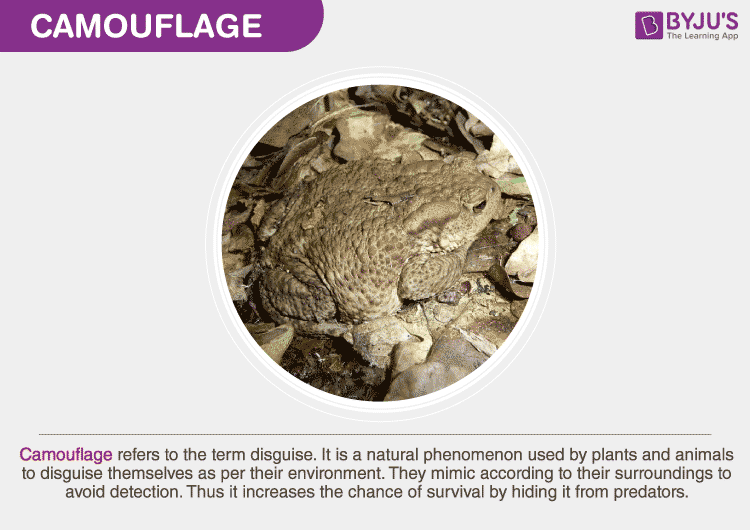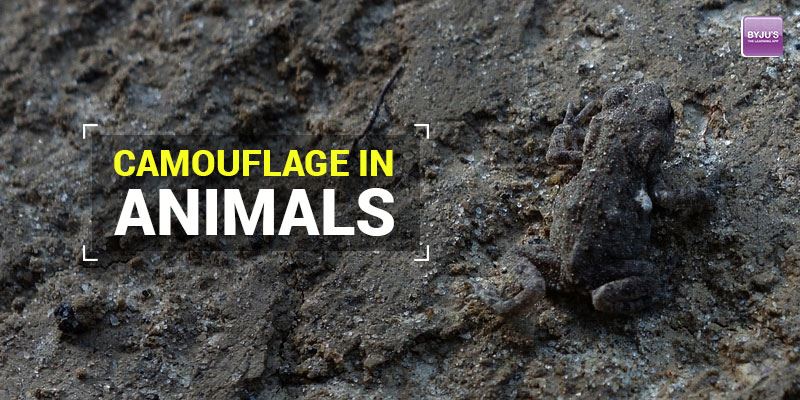Camouflage Definition
“Camouflage refers to the use of a combination of materials, illumination or colouration that makes an animal blend in with its environment, or makes it harder to spot. Some types of camouflage are also used to disguises animals as something else.”
What is Camouflage?
Camouflage is a natural phenomenon used by plants and animals to blend into their environment. Predators and prey alike use camouflage to avoid detection.
During this phenomenon, prey may change their skin colour or disguise themselves as per their surrounding colour so that other predators cannot detect them. Predators, such as the Stone Flounder, a flatfish, lay still on the ocean floor, buried under the sand, waiting for its prey.

The camouflage tactics of animals depend upon several factors. For eg., animals with fur use different camouflage tactics than those with scales and feathers. This is because fur takes months and weeks to change colour and shed, whereas scales can shed and change colours quickly.
Camouflage can be created in two ways:
- With the help of pigments
- With physical structures
Octopus bears microscopic pigments called biochromes that absorbs and reflects light to change the real colour of the animal.
On the other hand, animals such as polar bears have specific physical structures in their hair that scatter light of all colours, and the animal appears white.
Also Read: Adaptation and Habitats
Camouflage Animals
Camouflage animals are the animals that use camouflage to disguise themselves as per their surroundings to protect them from predators, or attack prey.
Animals mainly use camouflage to:
- Hide from their predators.
- Make it difficult for their prey to escape and sneak up.
- Use colouring and markings to blend into their environments.

Types of Camouflage in Animals
Concealing Colouration
Most of the forest habitat animals are brown, and animals of Arctic and tundra region are white. Here animal hides against a background of the same colour in order to protect themselves from predators and also for hunting their prey.
- Few animals like the snowshoe hare, found in North American regions change their body colour to hide from its prey-lynx. These species are usually white in winter, and their fur changes to brown during summer by shedding their fur.
- Chameleons change their colour to hide and to reflect their mood.
- Octopus can change both colour and skin texture.
Disruptive Colouration
The dark spots or stripes found on the animal’s skin are mainly used to camouflage themselves and to escape from their predators.
- A group of zebras heaving together looks like a large mass to a lion. This makes it hard for a lion to attack them.
- Predators like leopards and tigers have this disruptive colouration that helps in moving or hiding in between the branches before attacking its prey.
Disguise
The change in their appearance or colour which gets the blend with their surroundings by their colour, texture and shape.
This type of camouflage is mainly seen in insects like spiders, leaf butterfly, dragonfly katydid, stick bugs or stick insect, etc.
Mimicry
Most of the animals copycat or mimic other animals to fool and escape from their predators. The mimicry can either be in appearance or behaviour or sound or odour.
Viceroy butterflies mimic monarch butterfly to safeguard them from their predators –like birds. Birds never attack monarch butterfly as they are poisonous.
Also Read: Bioluminescence
Examples Of Camouflage Animals
Following are a few examples of camouflage animals:
- Owl
- Uroplatus Geckos
- Toads
- Seahorse
- Frog
- Spider
- Stick insect
- Snow Leopard
Also Read: Industrial Melanism
To learn more about camouflage and camouflage animals, keep visiting BYJU’S website or download BYJU’S app for further reference.
Frequently Asked Questions
What are the different types of camouflage?
The different types of camouflage include:
- Concealing colouration
- Disruptive colouration
- Mimicry
- Disguise
Give a few examples of camouflage animals.
- Owl
- Frog
- Snakes
- Spider
How does camouflage work in animals?
The colour, shape or texture of an animal helps them to blend with the environment. The animals have specialised cells in their body that help them to rearrange the pigment molecules that changes the colour pattern in their skin.
What is aposematism?
Aposematism is the appearance of the animal that warns the predator that the animal is toxic, distasteful or dangerous.

Comments